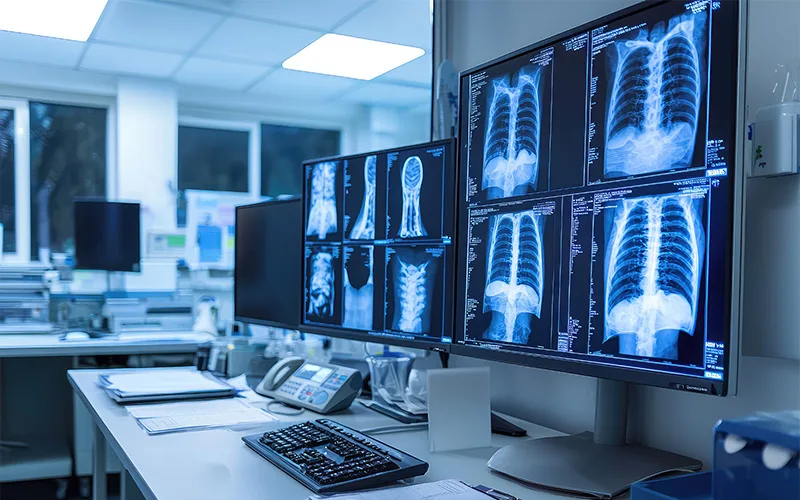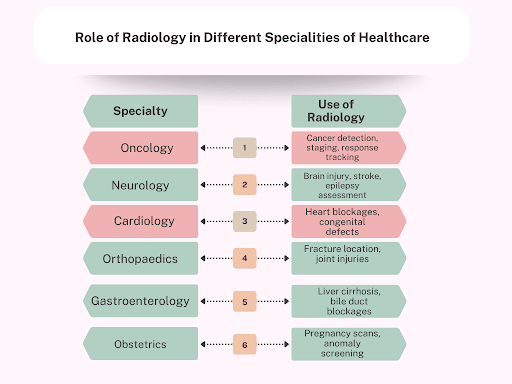

Modern healthcare doesn’t begin in the operating theatre or end at the prescription pad; it begins with a scan. Every major decision, from diagnosis to treatment, is guided by what shows up on that screen. And in that space between uncertainty and clarity stands one field: radiology.
Previously considered a back-seat speciality, radiology has now evolved into a dynamic as well as highly critical area of clinical care. Today, it is arguably the foundation of precision medicine. It bridges departments, drives decisions and brings visibility to what the human eye cannot see. But more importantly, it’s evolving rapidly.
In today’s era, radiology is not only about interpreting images. It is interpreting data. Artificial Intelligence is no longer an experiment – it’s embedded into diagnostic workflows. Algorithms support everything from stroke detection to cancer staging. Machine learning tools triage urgent cases before they reach a human reader. Across India and globally, imaging departments are becoming testbeds for technological transformation. The radiologist, as a result, is no longer just an image reader. They are becoming data interpreters, systems thinkers and key decision-makers.
This blog breaks down why a radiology course is no longer just another allied health option, but a gateway into the future of tech-enabled healthcare.
In this article
ToggleRadiology didn’t wait for technology to catch up.
It was already digital when others were still using paper. Radiologists have long used systems like PACS (Picture Archiving and Communication Systems) to store and view scans. These digital roots made it the perfect space to test artificial intelligence.
When computer scientists built early models to detect pneumonia or brain bleeds, radiology provided the training data. With over a decade of scan archives, consistent file formats and labelled outcomes, the radiology course quietly became the ground zero of medical AI.
Take the use of AI in screening mammograms. In cities like Mumbai and Bengaluru, AI-backed tools now help triage high-risk patients faster. They flag issues before a radiologist sees the scan, helping reduce human error and improve turnaround time.
This didn’t come from guesswork. It came from students who trained on both anatomy and algorithms. From radiologists who knew how to interpret what machines flagged.
This is where new students step in. A future-proof radiology course doesn’t just teach scanning. It teaches how to work with tools that learn from every scan.
A radiologist is no longer just a person behind a screen.
In top hospitals, radiologists are now part of diagnostic teams. They read not just images but the full clinical picture. Blood reports, genetic markers and pathology slides are now all part of one decision.
This approach is called multimodal diagnosis. And it’s changing everything.
Let’s say a patient has a liver lesion. Earlier, a scan might suggest surgery or not. Today, that same scan, when combined with blood markers and biopsy results, gives a more precise direction. Whether to operate, observe or treat with medication. The radiologist leads that call.
In institutions like AIIMS and PGI, radiologists are at the core of multidisciplinary tumour boards. They guide the group using visual evidence backed by deep interpretation.
For students taking up a radiology course, this means they must learn how to read across data types. Not just see but interpret. Not just diagnose but influence decisions.
A radiology course today is very different from what it was a decade ago.
Students aren’t just learning how to handle CT, MRI or ultrasound. They are learning:
Students now must know how to question an AI’s result. They must explain the scan not just to a surgeon but to a patient’s family. They must translate what machines generate into what humans can act on.
There’s a common myth that AI will replace radiologists.
This isn’t just wrong; it’s backwards. AI doesn’t eliminate the radiologist. It supports them.
Here’s what AI can do:
Here’s what AI can’t do:
Students entering a radiology course must not see AI as competition. They must see it as a second set of eyes – always working, never tired.
What matters most now is how students prepare to lead that partnership. How do they train to be the ones who understand the scan, the algorithm and the responsibility?
Many believe machines will replace people. It’s a common worry, especially in healthcare.
But in radiology, machines don’t replace. They assist. This is where the radiologist steps in.
The radiology course prepares students for that middle ground, where smart machines need smarter people. One learns how to read, judge and confirm what algorithms suggest.
Take stroke diagnosis.
AI might flag a bleed on a CT scan. But it’s the radiologist who checks if that matches the patient’s signs. It’s the radiologist who informs the emergency team whether to act or wait.
In India, several hospitals have added AI tools to their workflow. But they all still rely on human expertise. Radiologists work faster now, but not fewer.
Students entering a radiology course today train for this hybrid work setting.
Radiology is not a side department. It touches every major area in healthcare.
If a surgeon plans to remove a tumour, it’s the radiologist who maps its location. If a child comes in after a fall, it’s the radiologist who rules out a fracture. If a woman visits for prenatal care, it’s the radiologist who tracks foetal growth.
Here’s how different branches rely on radiology:

Radiology doesn’t just help in diagnosis. It shapes the treatment.
Students in a radiology course don’t stay limited to one corner of the hospital. They grow into professionals who contribute across departments.
In rural India, access to specialists is limited. But access to radiology is expanding.
Mobile diagnostic vans now carry X-ray and ultrasound machines to remote areas. Some are equipped with portable devices that can send images over networks. A radiologist in a city can read a scan from a village miles away.
This is teleradiology. And it’s changing public health delivery.
Screening camps use radiology to detect tuberculosis, breast lumps and bone infections. Early diagnosis means early action. And often, it’s the only chance a patient gets.
The radiology course today trains students to work with both hardware and software. They learn how to operate machines. They also learn how to read and report from a distance.
For India’s growing rural and semi-urban needs, this is more than a skill. It’s a service.
When the goal is to become a healthcare professional who thrives in fast-paced diagnostic environments, choosing the right institution makes all the difference. Among the few universities in India where education and clinical practice truly come together, The Apollo University stands out for how closely its programmes are integrated with real-world healthcare.
As part of the Apollo Hospitals Group, a name known across India for clinical excellence, the university offers B.Sc. Imaging Technology and M.Sc. Medical Imaging Technology programmes.
The faculty includes seasoned technologists, radiologists and healthcare educators. And the learning goes beyond textbooks – into labs, hospitals and structured clinical training that builds both skill and confidence.
With Apollo’s vast hospital network, career opportunities open up across diagnostics, research, imaging tech support and clinical practice. Strong placement support, access to industry experts and real patient-facing experience ensure that students graduate ready, relevant and respected.
Whether one is starting out or looking to specialise further, programmes like the M.Sc. Radiology and Imaging Technology go beyond theory to build confident, industry-ready imaging professionals.
A good career is one that evolves. A great one leads change.
Radiology has moved to AI systems. But it still rests on the shoulders of those who know how to interpret, explain and decide.
Students who take up a radiology course today don’t just train for today’s hospitals. They prepare for tomorrow’s challenges. Cross-department roles. AI partnerships. Public health missions. Diagnostic decisions with real impact.
What makes this field special isn’t just the technology. It’s the way that human thinking guides that technology to save lives.
For anyone looking to build a meaningful, skilled and secure career in healthcare, radiology is no longer an option on the side. It is the front line.
For students who are looking to begin a radiology journey with clinical grounding, technological fluency and unmatched industry alignment, The Apollo University offers a clear, future-ready path to professional success.
Admissions are now open. Apply today, and train where healthcare meets innovation.
Yes. AI supports radiologists. It helps them work faster, not replace them. The need for trained professionals has grown.
Radiology technician, MRI technologist, CT scan operator, optical laboratory technician, image analyst, diagnostic coordinator, etc.
Yes. With the right certification and training, many students take roles in district hospitals, PHCs and public screening projects.
